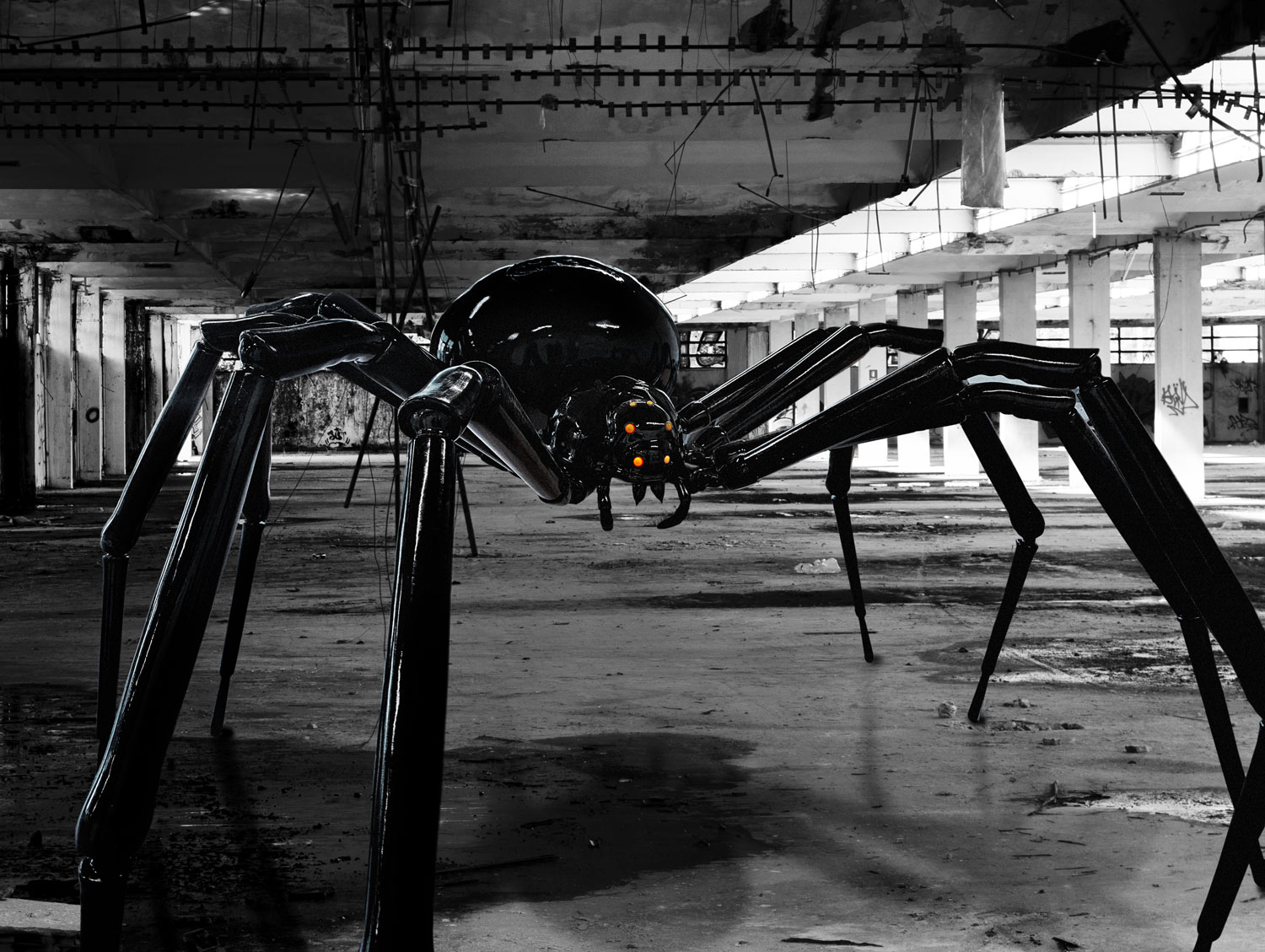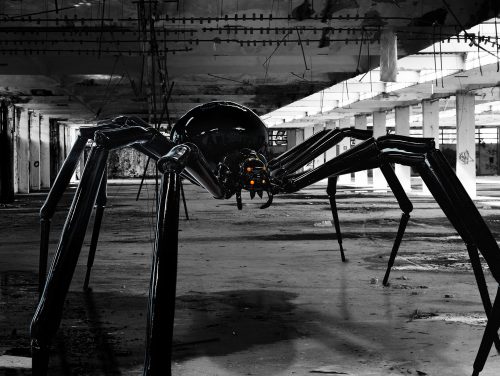Large Spider Prop
Large Spider Prop
We Build Custom Large 3D Spider Props
The Magic Behind Large Spider Props: A Deep Dive into Spine-Chilling Creations
As the Halloween season looms ever closer, or as a horror film studio gears up for its next spine-tingling venture, one creature stands head and shoulders (or should we say legs) above the rest when it comes to giving us goosebumps: spiders. But we’re not just talking about your average household arachnid. Oh no, we’re diving into the world of oversized, magnificently terrifying spider props that invoke a blend of awe, wonder, and outright fear. How are these gargantuan eight-legged monstrosities conceived, designed, and constructed? What roles do they play in various settings, be it a haunted mansion or a big-budget horror film? In this blog post, we’ll pull back the curtain and unveil the mysterious and thrilling world of these gigantic creepy-crawlies.
The Historical and Cultural Backdrop: Understanding the Symbolic Gravity
To fully comprehend the craft and purpose behind the awe-inspiring large spider props, it is crucial to delve into their rich historical and cultural significance. Spiders have been entangled in human stories for centuries, serving as both potent symbols and narrative catalysts in numerous cultures around the world. From the enduring Greek legend of Arachne, who was transformed into a spider by Athena, to the African tales of Anansi, the trickster spider, these eight-legged creatures have always occupied a unique space in our collective imagination. They represent various themes such as creativity, cunning, mystery, and sometimes even impending peril or danger.
Spiders have been particularly fascinating because they straddle the line between repulsion and attraction, physicality and symbolism. This paradoxical relationship has been maximally exploited in many forms of storytelling. As theatrical productions, blockbuster films, and Halloween-themed venues continued to seek out the perfect element that would both fascinate and terrify audiences, the humble spider swiftly emerged as an irrefutable candidate. However, to fully encapsulate the grandiosity and inherent fright of the spider’s mythological and symbolic presence, the standard, garden-variety spider just wouldn’t suffice. Hence, the stage was set for the entrance of the large spider props, creations designed to make the skin crawl while simultaneously pulling the spectators into a web of awe and wonder.
 This enormous 10’x10′ black widow spider was created for a store to be hung from the ceiling via a built-in cable. The eyes and hourglass mark are illuminated with LED lights.
This enormous 10’x10′ black widow spider was created for a store to be hung from the ceiling via a built-in cable. The eyes and hourglass mark are illuminated with LED lights.
The Advent of the Gigantic Spider: From Concept to Reality
It quickly became clear that if one was to infuse the element of terror effectively, a mere spider prop of average dimensions simply wouldn’t cut it. To genuinely induce heart-pounding fear or to manifest the spider as a monumental figure in a story, there was a pressing need to think bigger—much bigger. Thus was born the mesmerizing and haunting realm of oversized spider props, capable of looming over human actors and environments alike with an ominous aura. From initial concept sketches to material selection, from intricate carving to detailed painting, the creation of a large spider prop is a labor-intensive endeavor that demands both artistic finesse and engineering skill.
The Masterful Symphony of Crafting Colossal Arachnid Props: A Comprehensive Guide to Each Nuanced Step
Constructing a large spider prop that manages to captivate audiences while maintaining an authentic, realistic look is a complex endeavor, one that perfectly marries artistic vision with mechanical engineering. Here’s a step-by-step exploration into the intricate and multi-layered process, which reveals the immense thought, skill, and creativity required to bring such a chilling creature to life.
The Initial Phase of Conceptualization: Where Imagination Meets Paper
The inception of the grand arachnid prop begins in the fertile grounds of imagination, eventually taking its first tangible form on paper or digital canvas. Talented designers labor over preliminary sketches, diligently defining the spider’s dimensions, posture, texture, and other minute details that will eventually make it lifelike. But the design isn’t solely governed by aesthetics; practical considerations also play a crucial role. Depending on the intended setting—whether the spider is envisioned as hanging from a ceiling, crawling on a wall, or remaining stationary on a surface—different design elements may come into focus. Further, the spider’s functionality, be it static or animatronic, exerts significant influence over the design specifics. For example, an animatronic spider may require more articulating parts or segments to facilitate smooth movement.
The Essential Framework: Constructing the Spider’s Robust Skeleton
Once the conceptual foundation is set, the next step involves constructing the spider’s structural framework, most commonly fabricated from sturdy materials like metal or PVC. This skeleton serves as the anchor point for all the other elements that will be added later, providing both form and stability. Given that many large spider props are animatronic—capable of a range of movements from subtle articulation to dramatic gestures—this structural skeleton is engineered to bear mechanical components, ensuring durability and safety as it comes to life.
Crafting the Body: The Quest for Lifelike Realism and Textural Perfection
The ‘fleshing out’ of our soon-to-be colossal arachnid comes next, employing materials such as foam, latex, or fiberglass to add volume and shape. The tactile texture and the physical form are established during this stage, and it is pivotal for lending the creature its ultimate realism. Here, the artists and engineers work in harmonious collaboration to ensure that the spider not only looks real but feels real to the touch, achieving a mesmerizing level of detail that is both captivating and haunting.
The Art of Detailing: Where the Aesthetic Magic Unfolds
Detailing is the stage where the spider prop truly metamorphoses into an uncannily lifelike creature. Skilled artists painstakingly focus on the most minute features such as fangs, eyes, and even the hair that covers a spider’s legs and abdomen. Advanced techniques like airbrushing are employed to add depth to the prop, providing it with gradients of color, natural-looking shadows, and a dynamic texture that collectively serve to enhance its eerie, lifelike appearance.
Instilling Mobility: The Science of Bringing the Static to Life
For those spider props that are engineered to be animatronic, the final stage of construction is all about infusing them with mobility. Advanced mechanical mechanisms are carefully embedded within the spider’s framework to enable a range of movements. These could range from subtle gestures like the slow movement of its legs to more dramatic actions such as a sudden lunge or leap. When activated, these mechanical elements animate the spider, transcending it from an impressive static object to a dynamic creature that can interact with its environment in hauntingly realistic ways.
So there you have it: a deep dive into the multi-faceted, highly skilled process of creating a large spider prop. Each step is a testament to the incredible balance of art and engineering, culminating in a creation that fascinates, terrifies, and captivates all who encounter it.
Uses of Large Spider Props
The applications of large spider props are diverse:
Haunted Houses: The controlled environment of a haunted house is perfect for these props. Dim lighting, coupled with fog machines, can make a large spider prop appear terrifyingly realistic.
Movie Sets: Films like ‘Harry Potter and the Chamber of Secrets‘ and ‘Eight Legged Freaks‘ have leveraged the awe-factor of large spider props to create unforgettable scenes.
Themed Parties: Over the top Halloween parties, or even jungle-themed parties, often use large spider props as centerpieces to create a thematic environment.
Retail Displays: During Halloween, stores looking to create a buzz around their products might place a giant spider prop in their display window.
Education & Museums: Life-sized or exaggerated models of spiders can be instrumental in educating people about these creatures, their anatomy, and their significance in the ecosystem.
The Emotional Impact
The mere sight of a spider, especially a gigantic one, can evoke a myriad of emotions. The scale and realism of large spider props tap into our primal fears. Arachnophobia, or the fear of spiders, is one of the most common phobias worldwide. Large spider props, in all their grandeur, can amplify this fear, making them perfect for horror-centric applications.
Yet, on the flip side, these props can also inspire wonder. For those not paralyzed by fear, the intricate details, mechanics, and sheer size can be a marvel to behold.
The realm of large spider props is a confirmation to human creativity and our timeless fascination with the mysterious world of spiders. These props blend artistry with engineering, providing spine-chilling experiences in haunted houses and memorable scenes in films.
Whether you’re an enthusiast looking to add a touch of horror to your event or just someone curious about the craftsmanship behind these gargantuan creatures, the world of large spider props is deep and captivating. And the next time you come face-to-face with one, take a moment to appreciate the effort and artistry that’s gone into making it come “alive”!
Contact us today to learn more about our 3D services and how we can help you achieve your goals.
